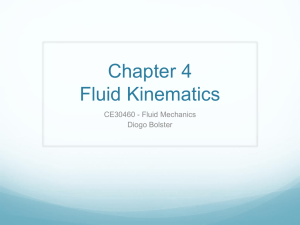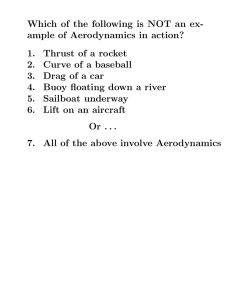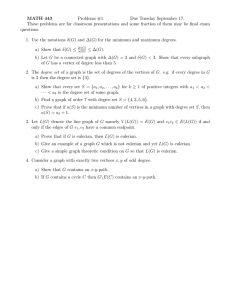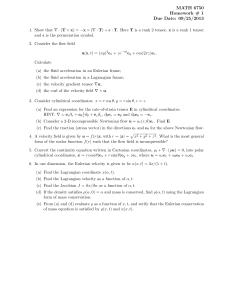Document 13659732
advertisement
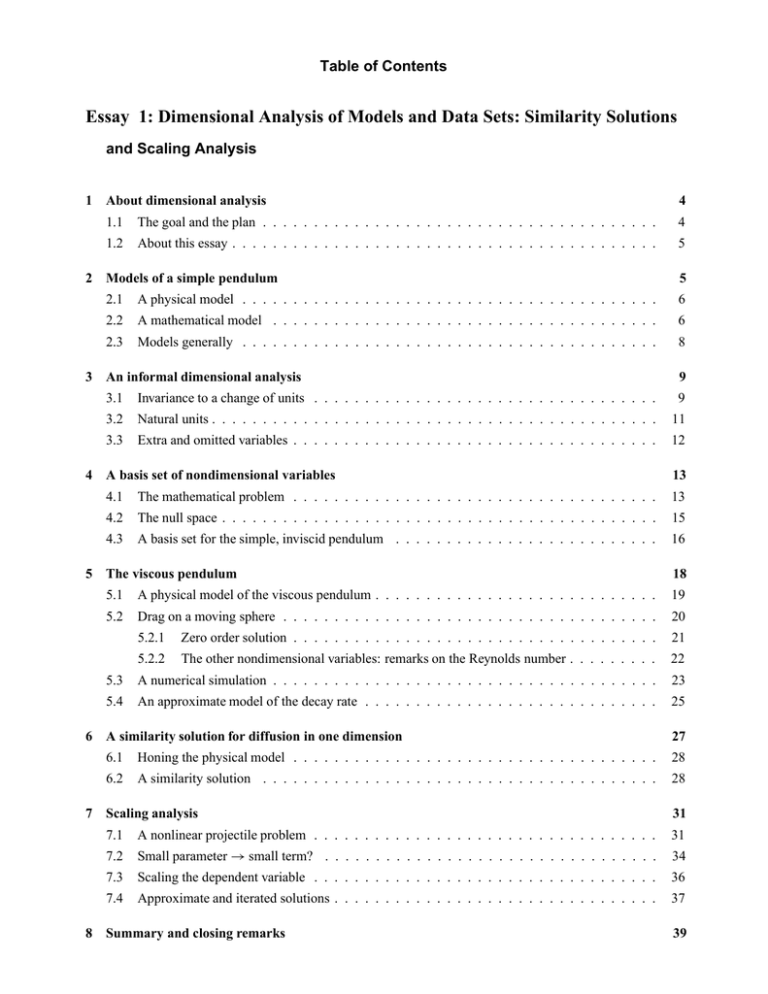
Table of Contents Essay 1: Dimensional Analysis of Models and Data Sets: Similarity Solutions and Scaling Analysis 1 About dimensional analysis 4 1.1 The goal and the plan . . . . . . . . . . . . . . . . . . . . . . . . . . . . . . . . . . . . . . . 4 1.2 About this essay . . . . . . . . . . . . . . . . . . . . . . . . . . . . . . . . . . . . . . . . . . 5 2 Models of a simple pendulum 5 2.1 A physical model . . . . . . . . . . . . . . . . . . . . . . . . . . . . . . . . . . . . . . . . . 6 2.2 A mathematical model . . . . . . . . . . . . . . . . . . . . . . . . . . . . . . . . . . . . . . 6 2.3 Models generally . . . . . . . . . . . . . . . . . . . . . . . . . . . . . . . . . . . . . . . . . 8 3 An informal dimensional analysis 9 3.1 Invariance to a change of units . . . . . . . . . . . . . . . . . . . . . . . . . . . . . . . . . . 9 3.2 Natural units . . . . . . . . . . . . . . . . . . . . . . . . . . . . . . . . . . . . . . . . . . . . 11 3.3 Extra and omitted variables . . . . . . . . . . . . . . . . . . . . . . . . . . . . . . . . . . . . 12 4 A basis set of nondimensional variables 13 4.1 The mathematical problem . . . . . . . . . . . . . . . . . . . . . . . . . . . . . . . . . . . . 13 4.2 The null space . . . . . . . . . . . . . . . . . . . . . . . . . . . . . . . . . . . . . . . . . . . 15 4.3 A basis set for the simple, inviscid pendulum . . . . . . . . . . . . . . . . . . . . . . . . . . 16 5 The viscous pendulum 18 5.1 A physical model of the viscous pendulum . . . . . . . . . . . . . . . . . . . . . . . . . . . . 19 5.2 Drag on a moving sphere . . . . . . . . . . . . . . . . . . . . . . . . . . . . . . . . . . . . . 20 5.2.1 Zero order solution . . . . . . . . . . . . . . . . . . . . . . . . . . . . . . . . . . . . 21 5.2.2 The other nondimensional variables: remarks on the Reynolds number . . . . . . . . . 22 5.3 A numerical simulation . . . . . . . . . . . . . . . . . . . . . . . . . . . . . . . . . . . . . . 23 5.4 An approximate model of the decay rate . . . . . . . . . . . . . . . . . . . . . . . . . . . . . 25 6 A similarity solution for diffusion in one dimension 27 6.1 Honing the physical model . . . . . . . . . . . . . . . . . . . . . . . . . . . . . . . . . . . . 28 6.2 A similarity solution . . . . . . . . . . . . . . . . . . . . . . . . . . . . . . . . . . . . . . . 28 7 Scaling analysis 31 7.1 A nonlinear projectile problem . . . . . . . . . . . . . . . . . . . . . . . . . . . . . . . . . . 31 7.2 Small parameter ! small term? . . . . . . . . . . . . . . . . . . . . . . . . . . . . . . . . . 34 7.3 Scaling the dependent variable . . . . . . . . . . . . . . . . . . . . . . . . . . . . . . . . . . 36 7.4 Approximate and iterated solutions . . . . . . . . . . . . . . . . . . . . . . . . . . . . . . . . 37 8 Summary and closing remarks 39 Essay 2: The Coriolis force 1 Large-scale flows of the atmosphere and ocean. 4 1.1 Classical mechanics observed from a rotating Earth . . . . . . . . . . . . . . . . . . . 8 1.2 The goal and the plan of this essay . . . . . . . . . . . . . . . . . . . . . . . . . . . . 11 1.3 About this essay . . . . . . . . . . . . . . . . . . . . . . . . . . . . . . . . . . . . . . 13 2 Part I: Rotating reference frames and the Coriolis force. 2.1 Kinematics of a linearly accelerating reference frame . . . . . . . . 2.2 Kinematics of a rotating reference frame . . . . . . . . . . . . . . . 2.2.1 Transforming the position, velocity and acceleration vectors 2.2.2 Stationary ⇒ Inertial; Rotating ⇒ Earth-Attached . . . . . 2.2.3 Remarks on the transformed equation of motion . . . . . . . 3 4 5 Inertial and noninertial descriptions of elementary motions. 3.1 Switching sides . . . . . . . . . . . . . . . . . . . . . . . . . 3.2 To get a feel for the Coriolis force . . . . . . . . . . . . . . . 3.2.1 Zero relative velocity . . . . . . . . . . . . . . . . . . 3.2.2 With relative velocity . . . . . . . . . . . . . . . . . . 3.3 An elementary projectile problem . . . . . . . . . . . . . . . 3.3.1 From the inertial frame . . . . . . . . . . . . . . . . . 3.3.2 From the rotating frame . . . . . . . . . . . . . . . . 3.4 Appendix to Section 3: Circular motion and polar coordinates. A reference frame attached to the rotating Earth. 4.1 Cancelation of the centrifugal force . . . . . . . . . . . . . 4.1.1 Earth’s (slightly chubby) figure . . . . . . . . . . . 4.1.2 Vertical and level in an accelerating reference frame 4.1.3 The equation of motion for an Earth-attached frame . 4.2 Coriolis force on motions in a thin, spherical shell . . . . . . 4.3 Why do we insist on the rotating frame equations? . . . . . 4.3.1 Inertial oscillations from an inertial frame . . . . . . 4.3.2 Inertial oscillations from the rotating frame . . . . . . . . . . . . . . . . . . . . . . . . . . . . . . . . . . . . . . . . . . . . . . . . . . . . . . . . . . . . . . . . . . . . . . . . . . . . . . . . . . . . . . . . . . . . . . . . . . . . . . . . . . . . . . . . . . . . . . . . . . . . . . . . . . . . . . . . . . . . . . . . . . . . . . . . . . . . . . . . . . . . . . . . . . . . . . . . . . . . . . . . . . . . . . . . . . . . . . . . . . . . . . . . . . . . . . . . . . . . . . . . . . . . . . . . . . . . . . . . . . . . . . . . . . . . . . . 14 15 17 17 24 26 . . . . . . . . 27 28 30 31 32 34 34 34 37 . . . . . . . . 38 39 39 41 41 42 44 45 47 A dense parcel on a slope. 49 5.1 Inertial and geostrophic motion . . . . . . . . . . . . . . . . . . . . . . . . . . . . . . 54 3 1 LARGE-SCALE FLOWS OF THE ATMOSPHERE AND OCEAN. 5.2 6 7 4 Energy budget . . . . . . . . . . . . . . . . . . . . . . . . . . . . . . . . . . . . . . . 56 Part II: Geostrophic adjustment and potential vorticity. 6.1 The shallow water model . . . . . . . . . . . . . . . 6.2 Solving and diagnosing the shallow water system . . 6.2.1 Energy balance . . . . . . . . . . . . . . . . 6.2.2 Potential vorticity balance . . . . . . . . . . 6.3 Linearized shallow water equations . . . . . . . . . . . . . . . . . . . . . . . . . . . . . . Models of the Coriolis parameter. 7.1 Case 1, f = 0, non rotating . . . . . . . . . . . . . . . . . . 7.2 Case 2, f = constant, an f-plane, . . . . . . . . . . . . . 7.3 Case 3, f = fo + βy, a β-plane, . . . . . . . . . . . . . . . 7.3.1 Beta-plane phenomena . . . . . . . . . . . . . . . . 7.3.2 Rossby waves; low frequency waves on a beta plane 7.3.3 Modes of potential vorticity conservation . . . . . . 7.3.4 Some of the varieties of Rossby waves . . . . . . . . . . . . . . . . . . . . . . . . . . . . . . . . . . . . . . . . . . . . . . . . . . . . . . . . . . . . . . . . . . . . . . . . . . . . . . . . . . . . . . . . . . . . . . . . . . . . . . . . . . . . . . . . . . . . . . . . . . . . . . . . . . . . . . . . . . . . . . . . . . . . . . . . . . . . . . . . . . . . . . . . . 57 58 60 61 61 65 . . . . . . . 65 66 70 77 78 82 86 87 8 Summary of the essay. 90 9 Supplementary material. 92 9.1 Matlab and Fortran source code . . . . . . . . . . . . . . . . . . . . . . . . . . . . . 92 9.2 Additional animations . . . . . . . . . . . . . . . . . . . . . . . . . . . . . . . . . . . 93 Essay 3: Lagrangian and Eulerian Representations of Fluid Flow: Kinematics and the Equations of Motion 1 The challenge of fluid mechanics is mainly the kinematics of fluid flow. 1.1 Physical properties of materials; what distinguishes fluids from solids? 4 . . . . . . . . . . . . 5 1.1.1 The response to pressure — in linear deformation liquids are not very different from solids . . . . . . . . . . . . . . . . . . . . . . . . . . . . . . . . . . . . . . . . . . . 6 1.1.2 The response to shear stress — solids deform and fluids flow . . . . . . . . . . . . . 9 1.2 A first look at the kinematics of fluid flow . . . . . . . . . . . . . . . . . . . . . . . . . . . . 13 1.3 Two ways to observe fluid flow and the Fundamental Principle of Kinematics . . . . . . . . . 14 1.4 The goal and the plan of this essay; Lagrangian to Eulerian and back again . . . . . . . . . . . 17 2 The Lagrangian (or material) coordinate system. 19 2.1 The joy of Lagrangian measurement . . . . . . . . . . . . . . . . . . . . . . . . . . . . . . . 21 2.2 Transforming a Lagrangian velocity into an Eulerian velocity . . . . . . . . . . . . . . . . . . 23 2.3 The Lagrangian equations of motion in one dimension . . . . . . . . . . . . . . . . . . . . . 24 2.3.1 Mass conservation; mass is neither lost or created by fluid flow . . . . . . . . . . . . . 24 2.3.2 Momentum conservation; F = Ma in a one dimensional fluid flow . . . . . . . . . . . 28 2.3.3 The one-dimensional Lagrangian equations reduce to an exact wave equation . . . . . 30 The agony of the three-dimensional Lagrangian equations . . . . . . . . . . . . . . . . . . . . 31 2.4 3 The Eulerian (or field) coordinate system. 33 3.1 Transforming an Eulerian velocity field to Lagrangian trajectories . . . . . . . . . . . . . . . 34 3.2 Transforming time derivatives from Lagrangian to Eulerian systems; the material derivative . . 35 3.3 Transforming integrals and their time derivatives; the Reynolds Transport Theorem . . . . . . 38 3.4 The Eulerian equations of motion . . . . . . . . . . . . . . . . . . . . . . . . . . . . . . . . . 41 3.4.1 Mass conservation represented in field coordinates . . . . . . . . . . . . . . . . . . . 41 3.4.2 The flux form of the Eulerian equations; the effect of fluid flow on properties at a fixed position . . . . . . . . . . . . . . . . . . . . . . . . . . . . . . . . . . . . . . . . . . 44 3.4.3 Momentum conservation represented in field coordinates . . . . . . . . . . . . . . . . 46 3.4.4 Fluid mechanics requires a stress tensor (which is not as difficult as it first seems) . . . 47 3.4.5 Energy conservation; the First Law of Thermodynamics applied to a fluid . . . . . . . 53 A few remarks on the Eulerian equations . . . . . . . . . . . . . . . . . . . . . . . . . . . . . 54 3.5 4 Depictions of fluid flows represented in field coordinates. 55 4.1 Trajectories (or pathlines) are important Lagrangian properties . . . . . . . . . . . . . . . . . 55 4.2 Streaklines are a snapshot of parcels having a common origin . . . . . . . . . . . . . . . . . . 58 4.3 Streamlines are parallel to an instantaneous flow field . . . . . . . . . . . . . . . . . . . . . . 58 5 Eulerian to Lagrangian transformation by approximate methods. 60 5.1 5.2 Tracking parcels around a steady vortex given limited Eulerian data . . . . . . . . . . . . . . 60 5.1.1 The zeroth order approximation, or PVD . . . . . . . . . . . . . . . . . . . . . . . . 60 5.1.2 A first order approximation, and the velocity gradient tensor . . . . . . . . . . . . . . 61 Tracking parcels in gravity waves . . . . . . . . . . . . . . . . . . . . . . . . . . . . . . . . 63 5.2.1 The zeroth order approximation, closed loops . . . . . . . . . . . . . . . . . . . . . . 64 5.2.2 The first order approximation yields the wave momentum and Stokes drift . . . . . . . 64 6 Aspects of advection, the Eulerian representation of fluid flow. 67 6.1 The modes of a two-dimensional thermal advection equation . . . . . . . . . . . . . . . . . . 68 6.2 The method of characteristics implements parcel tracking as a solution method . . . . . . . . 70 6.3 A systematic look at deformation due to advection; the Cauchy-Stokes Theorem . . . . . . . . 74 6.3.1 The rotation rate tensor . . . . . . . . . . . . . . . . . . . . . . . . . . . . . . . . . . 77 6.3.2 The deformation rate tensor . . . . . . . . . . . . . . . . . . . . . . . . . . . . . . . 79 6.3.3 The Cauchy-Stokes Theorem collects it all together . . . . . . . . . . . . . . . . . . . 81 7 Lagrangian observation and diagnosis of an oceanic flow. 82 8 Concluding remarks; where next? 86 9 Appendix: A Review of Composite Functions 87 ; 9.1 Definition . . . . . . . . . . . . . . . . . . . . . . . . . . . . . . . . . . . . . . . . . . . . . 88 9.2 Rules for differentiation and change of variables in integrals . . . . . . . . . . . . . . . . . . 89 MIT OpenCourseWare http://ocw.mit.edu Resource: Online Publication.Fluid Dynamics James Price The following may not correspond to a particular course on MIT OpenCourseWare, but has been provided by the author as an individual learning resource. For information about citing these materials or our Terms of Use, visit: http://ocw.mit.edu/terms.


